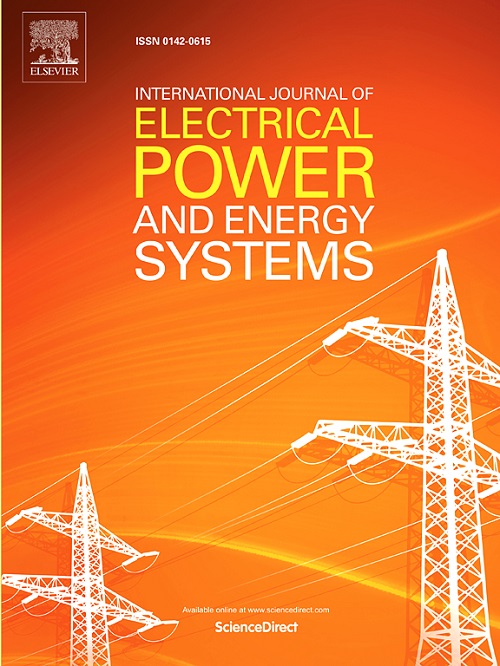Autonomous grid-forming inverter exponential droop control for improved frequency stability
IF 5
2区 工程技术
Q1 ENGINEERING, ELECTRICAL & ELECTRONIC
International Journal of Electrical Power & Energy Systems
Pub Date : 2025-09-25
DOI:10.1016/j.ijepes.2025.111160
引用次数: 0
Abstract
This paper introduces a novel control strategy for grid-forming inverter-based resources, Droop-e, which establishes a non-linear, active power–frequency droop relationship based on an exponential function of the power output. A primary advantage of Droop-e as compared to traditional linear droop is an increased utilization of available power headroom that directly mitigates system frequency excursions and reduces the rate of change of frequency. First, the motivation for Droop-e as compared to a linear grid-forming control is established, and then the full control system is described, including the mirrored inversion at the origin, the linearization at a parameterized limit, and the auxiliary autonomous power sharing controller. Subsequently, the analytic stability of the controller is assessed, including a continuity and smoothness proof, adherence to synchronization criteria, and a small-signal stability analysis. This is followed by electromagnetic transient simulations of this controller with full order inverter models and accompanying DC-side dynamics, connected in parallel with synchronous generators for an exhaustive range of dispatches on a simple 3-bus system. Finally, IEEE 39-bus system simulations highlight the improved frequency stability of the system with multiple, Droop-e controlled grid-forming inverters.
自主成网逆变器指数下垂控制提高频率稳定性
本文介绍了一种基于并网逆变器资源的新型控制策略——下垂-e,该策略基于功率输出的指数函数建立了非线性有源工频下垂关系。与传统的线性下垂相比,下垂-e的主要优点是增加了可用功率净空的利用率,直接减轻了系统频率偏移并降低了频率变化率。首先,建立了与线性网格形成控制相比的Droop-e的动机,然后描述了完整的控制系统,包括原点的镜像反演,参数化极限的线性化以及辅助的自主功率共享控制器。随后,评估了控制器的分析稳定性,包括连续性和平滑性证明,遵守同步标准和小信号稳定性分析。接下来是该控制器的电磁瞬态仿真,具有全阶逆变器模型和伴随的直流侧动力学,并与同步发电机并联,在简单的3总线系统上进行详尽的调度。最后,IEEE 39总线系统仿真强调了使用多个下垂e控制的并网逆变器可以提高系统的频率稳定性。
本文章由计算机程序翻译,如有差异,请以英文原文为准。
求助全文
约1分钟内获得全文
求助全文
来源期刊
CiteScore
12.10
自引率
17.30%
发文量
1022
审稿时长
51 days
期刊介绍:
The journal covers theoretical developments in electrical power and energy systems and their applications. The coverage embraces: generation and network planning; reliability; long and short term operation; expert systems; neural networks; object oriented systems; system control centres; database and information systems; stock and parameter estimation; system security and adequacy; network theory, modelling and computation; small and large system dynamics; dynamic model identification; on-line control including load and switching control; protection; distribution systems; energy economics; impact of non-conventional systems; and man-machine interfaces.
As well as original research papers, the journal publishes short contributions, book reviews and conference reports. All papers are peer-reviewed by at least two referees.

 求助内容:
求助内容: 应助结果提醒方式:
应助结果提醒方式:


